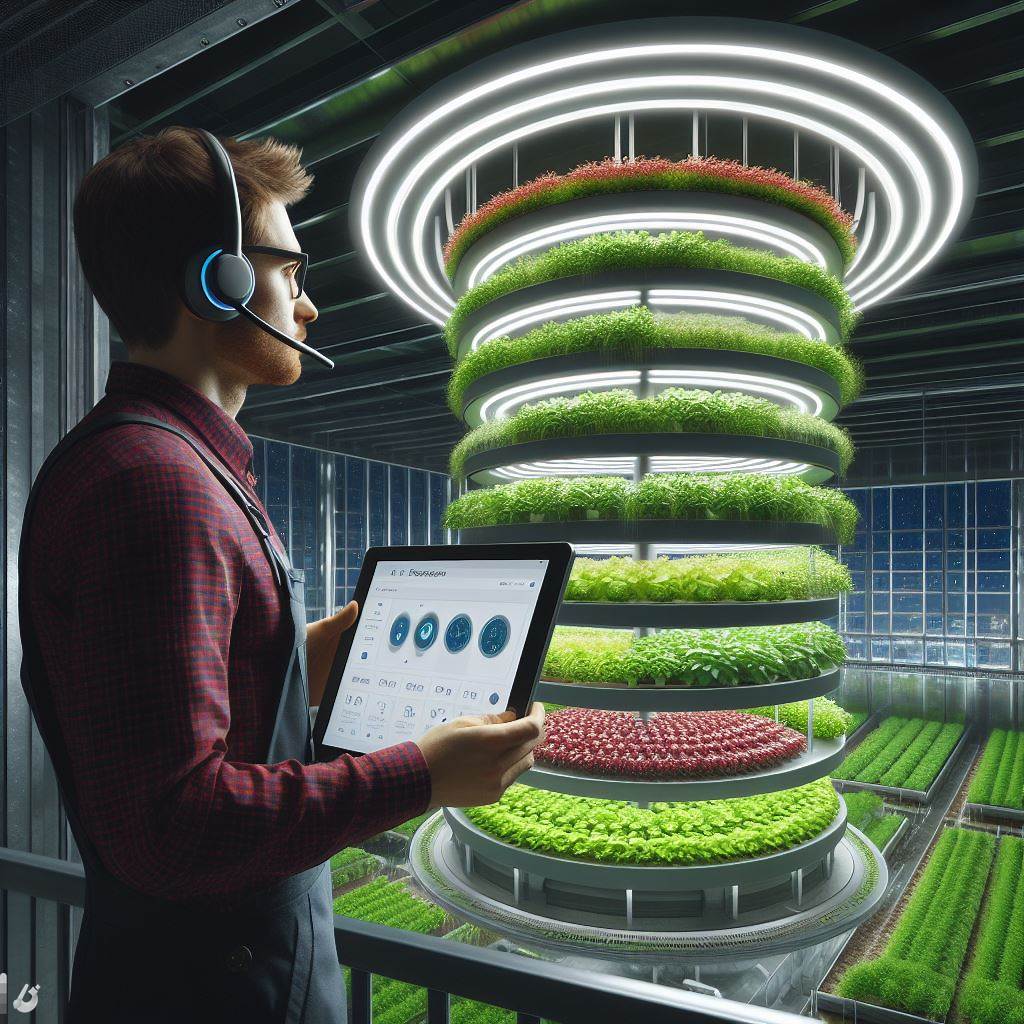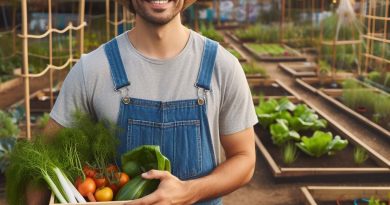Top 5 Trends in Vertical Farming Tech
Last Updated on January 18, 2024
Introduction
A. Importance of Vertical Farming
Vertical farming is revolutionizing agriculture, offering sustainable solutions to feeding our growing global population.
Its importance lies in efficient space utilization, reduced environmental impact, and year-round crop production.
B. Purpose of the Blog Post
This blog post delves into the dynamic world of vertical farming technology.
Discover the latest trends shaping the future of agriculture, propelling us towards a more sustainable and resilient food production system.
C. Overview of the Top 5 Trends in Vertical Farming Tech
1. Advanced Automation
- Precision farming through automated systems.
- AI-driven monitoring for optimal resource utilization.
2. Vertical Stackable Systems
- Maximizing space with tiered growing structures.
- Efficient land use and increased crop yield.
3. LED Technology Integration
- Tailored light spectrums for accelerated plant growth.
- Energy-efficient lighting systems for cost-effective operations.
4. Hydroponics and Aeroponics
- Soilless cultivation for water conservation.
- Nutrient-rich misting systems for enhanced plant development.
5. Data-Driven Decision Making
- Utilizing big data for crop management.
- Predictive analytics for proactive farming strategies.
Embark on a journey through these trends, shaping the landscape of modern agriculture through vertical farming innovation.
Automation and Robotics
A. Benefits of Automation in Vertical Farming
- Increased efficiency: Automation eliminates the need for manual labor, reducing human error and increasing production speed.
- Cost savings: With automation, vertical farms can lower labor costs and reduce overall operational expenses.
- Consistent quality: Robotic systems ensure precise and consistent control over various factors like irrigation and nutrient distribution.
- Space optimization: Automated systems can utilize space more efficiently, making the most of vertical farming’s vertical layout.
- Reduced resource consumption: Automation allows for optimized resource usage by monitoring and adjusting variables in real-time.
B. Examples of Robotic Systems Used in Vertical Farming
- Automated Planting Systems: These robotic systems handle the sowing and planting of seeds, ensuring accuracy and uniformity.
- Robotic Harvesting: Machines equipped with computer vision and robotic arms selectively pick ripe produce, enhancing efficiency.
- Smart Irrigation Systems: Automated irrigation systems monitor moisture levels and water plants precisely, minimizing waste.
- Climate Control: Automated systems regulate temperature, humidity, and lighting conditions to create an optimal growth environment.
- Crop Monitoring: Robotics and sensors monitor plants, providing data on growth rates, nutrient levels, and pest infestations.
C. Impact of Automation on Efficiency and Productivity
- Improved Yield: Automation allows for constant monitoring and adjustment, optimizing growing conditions and maximizing output.
- Reduced Labor Dependency: Robotic systems lessen the reliance on human labor, addressing workforce challenges and labor shortages.
- Faster Turnaround Time: Automating tasks like planting and harvesting accelerates the production cycle, increasing overall productivity.
- Precise Resource Management: Automation enables precise control over resources like water, nutrients, and energy, minimizing waste.
- Scalability: Adopting automation in vertical farming facilitates scalability, allowing farms to expand production without significant manpower.
In short, automation and robotics play a crucial role in the advancement of vertical farming technology.
They offer numerous benefits such as increased efficiency, cost savings, consistent quality, and space optimization.
Through robotic systems like automated planting and harvesting, smart irrigation, climate control, and crop monitoring, vertical farms can achieve higher yield and reduced labor dependency.
Automation also enables precise resource management and scalability, leading to improved productivity and the sustainable growth of vertical farming.
Read: Climate Smart Agri: Tools & Techniques
LED Lighting Advancements
A. Introduction to LED lighting in vertical farming
LED lighting has become an essential aspect of vertical farming, providing artificial light to enhance plant growth and maximize yields.
With recent advancements, LED technology has brought about significant improvements in vertical farming practices.
B. Benefits of LED lighting for plant growth
- Energy efficiency: LED lights consume less energy compared to traditional lighting sources, making them more cost-effective for vertical farming operations.
- Tailored light spectrum: LED lights can be customized to emit specific wavelengths of light, promoting optimized photosynthesis and plant development.
- Long lifespan: LED lights have a longer life expectancy compared to conventional lighting, reducing replacement costs and maintenance efforts.
- Heat management: LED lights generate less heat, preventing damage to plants and providing a more controlled temperature environment in vertical farms.
- Increased yields: Due to the precise control over light spectrum and intensity, LED lighting can significantly boost crop yields.
C. Advancements in LED lighting technology
- Adjustable spectrum LEDs: New LED systems allow farmers to adjust the light spectrum based on crop needs and growth stages, providing optimal conditions throughout the plant’s lifecycle.
- Smart lighting systems: Integrated sensors and automation technology enable LED lights to mimic natural sunlight and adjust lighting levels based on environmental conditions.
- Vertical-specific lighting solutions: LED manufacturers are creating lighting systems designed explicitly for vertical farming setups, providing uniform coverage and vertical space utilization.
- UV LEDs: Incorporating ultraviolet light diodes in LED systems can promote intangible benefits such as enhanced flavor, nutritional content, and disease resistance in crops.
- Wireless connectivity and data analysis: LED lighting systems can now be integrated with wireless sensors and data analysis software, allowing farmers to monitor and optimize lighting parameters remotely.
Generally, LED lighting advancements have revolutionized vertical farming practices.
The energy-efficient and customizable nature of LEDs offer numerous benefits to plant growth while minimizing operational costs.
With the latest developments in LED technology, vertical farmers can achieve higher yields and better control over their crops’ quality.
By harnessing the power of LED lighting, vertical farming continues to push the boundaries of sustainable agriculture.
Read: Efficient Watering with IoT in Agri
Artificial Intelligence and Data Analytics
A. Integration of AI and data analytics in vertical farming
Vertical farming has seen a significant integration of artificial intelligence (AI) and data analytics in recent years.
This trend has revolutionized the way crops are grown and managed in indoor farming systems.
AI and data analytics have allowed vertical farmers to collect and analyze large amounts of data, enabling them to make more informed decisions regarding crop cultivation.
By harnessing the power of AI, farmers can optimize various aspects of their vertical farming operations.
B. Improving crop monitoring and decision-making processes
One of the key benefits of AI and data analytics in vertical farming is improved crop monitoring.
AI-powered systems can continuously monitor various environmental factors such as temperature, humidity, and lighting conditions inside vertical farms.
These systems can also track plant growth and development, ensuring that the crops are receiving the necessary care and nutrients.
Through real-time monitoring, farmers can quickly identify any anomalies or issues that may arise and take immediate action to address them, preventing crop losses.
Data analytics further enhances decision-making processes in vertical farming.
By analyzing the vast amount of data collected, AI systems can provide valuable insights and predictions.
This empowers farmers to optimize their crop cultivation strategies, improving yields and reducing costs.
C. Examples of AI-powered systems in vertical farming
There are several examples of AI-powered systems that have made significant contributions to vertical farming technology.
One such example is Plant.IO, an AI-driven vertical farming system developed by LettUs Grow.
Plant.IO utilizes machine learning algorithms to monitor and control the growth environment for crops.
It collects real-time data on temperature, humidity, and nutrient levels, allowing farmers to make data-driven decisions and optimize their production processes.
Another example is Plenty, an indoor farming company that combines AI and data analytics to create optimized growing conditions.
Their AI algorithms continuously analyze data from thousands of sensors to create the perfect environment for each crop, resulting in higher yields and consistent quality.
Vertical farming startup Bowery Farming also leverages AI and data analytics to maximize crop productivity.
Their AI-driven system tracks plant health and growth patterns, allowing for precise control of factors such as light spectrum and nutrient levels.
Essentially, the integration of artificial intelligence and data analytics has brought significant advancements to the field of vertical farming.
These technologies improve crop monitoring and decision-making processes, leading to higher yields, reduced costs, and more sustainable agricultural practices.
Read: Solar-Powered Irrigation: A Deep Dive

Vertical Stacking and Space Optimization
Vertical stacking and space optimization are key trends in vertical farming technology.
As the demand for sustainable and efficient agricultural practices continues to rise, farmers and entrepreneurs are looking for innovative ways to maximize space utilization in vertical farming systems.
In this section, we will explore the importance of vertical stacking, strategies for space optimization, and the latest innovations in vertical farming design and infrastructure.
A. Importance of vertical stacking in vertical farming
Vertical stacking refers to the practice of growing crops in multiple layers, utilizing the vertical space in a controlled environment.
This technique allows farmers to maximize their yield per square foot, making the most of limited space in urban areas.
Vertical stacking offers several advantages in vertical farming:
- Increased crop yield: By using vertical space effectively, farmers can grow more crops in the same area, resulting in higher yields compared to traditional farming methods. This is especially crucial in densely populated cities where arable land is scarce.
- Efficient resource utilization: Vertical stacking allows for more efficient use of resources such as water, fertilizers, and energy.
With crops stacked vertically, water and nutrients can be delivered directly to the plants, minimizing waste and optimizing resource allocation. - Reduced land requirements: Vertical farming eliminates the need for vast expanses of land, making it suitable for urban areas where land is limited and expensive.
By utilizing vertical space, farmers can produce a significant amount of food in a small footprint.
B. Strategies for maximizing space utilization
To optimize space utilization in vertical farming, farmers employ various strategies:
- Tiered shelving systems: These systems consist of multiple shelves or racks, allowing crops to be grown vertically.
By adjusting the spacing between shelves, farmers can accommodate different plant heights and optimize light distribution. - Vertical hydroponic systems: Hydroponics, a soilless cultivation method, allows crops to be grown vertically using nutrient-rich water solutions.
Vertical hydroponic towers or columns enable farmers to grow crops from floor to ceiling, maximizing space utilization. - Plant selection and arrangement: Certain crops are better suited for vertical farming due to their growth habits. Vine crops like tomatoes, cucumbers, and beans naturally climb or trail, making them ideal for vertical stacking.
Properly arranging crops based on their light and space requirements is crucial for optimal growth and yield.
C. Innovations in vertical farming design and infrastructure
To further enhance vertical farming’s efficiency and productivity, several innovations have emerged:
- Vertical farming skyscrapers: These tall buildings are specifically designed for vertical farming, housing multiple levels of crop production.
By harnessing advanced lighting, climate control, and automation technologies, vertical farming skyscrapers can yield crops year-round and at scale. - Aeroponics systems: Aeroponics is a cutting-edge cultivation technique that suspends plant roots in air and delivers water and nutrient solutions through a misting system.
This method eliminates the need for soil or growing medium, and its vertical nature allows for maximum space utilization. - Modular farming units: Modular units offer flexibility in vertical farming systems, allowing farmers to customize the design and scale of their operations.
These units can be easily assembled and disassembled, making them suitable for both urban and rural environments.
In general, vertical stacking and space optimization are crucial trends in vertical farming technology.
By utilizing vertical space effectively and employing innovative strategies and designs, farmers can produce more food while conserving resources and minimizing the land footprint.
As the demand for sustainable food production continues to grow, vertical farming technology holds immense potential in feeding our increasingly urbanized world.
Read: Agri Robots: The Future of Farming Now
Hydroponics and Aeroponics Advancements
A. Introduction to Hydroponics and Aeroponics in Vertical Farming
Vertical farming has revolutionized the way we grow crops, and hydroponics and aeroponics are at the forefront of this agricultural innovation.
In traditional farming, soil is the primary medium for plants to grow, but in hydroponics and aeroponics, soil is eliminated from the equation.
Hydroponics involves growing plants in a nutrient-rich water solution, while aeroponics grows plants in an air or mist environment without soil or water.
Both methods allow growers to have more control over the plants’ growing conditions, resulting in higher yields and healthier crops.
B. Benefits of Hydroponics and Aeroponics
- Water Conservation: Hydroponics and aeroponics significantly reduce water usage compared to traditional farming methods.
In hydroponics, water is recirculated in a closed loop system, minimizing waste. Aeroponics uses up to 90% less water than traditional soil-based farming. - Space Efficiency: Vertical farming relies on maximizing space, and hydroponics and aeroponics are perfect for this purpose.
Without soil, plants can be stacked vertically, allowing for more greenery in a smaller area. This is particularly advantageous in urban environments where space is limited. - Nutrient Control: In hydroponics and aeroponics, growers have precise control over the nutrient composition for their plants.
This allows for optimal growth conditions and eliminates the risk of nutrient deficiencies or excesses commonly found in traditional farming. - Pest Management: Soil-borne pests and diseases pose a significant risk to crops. By eliminating soil in hydroponics and aeroponics, growers can reduce the likelihood of pest infestations, resulting in healthier plants that require fewer pesticides and chemical treatments.
C. Latest Advancements in Hydroponics and Aeroponics Technology
- Vertical Tower Systems: These systems feature multiple levels of stacked trays or channels, allowing for efficient use of vertical space.
They provide individual water and nutrient supply to each plant, ensuring optimal growth conditions. - Smart Sensor Technologies: To further enhance crop production, sensors are being integrated into hydroponic and aeroponic systems.
These sensors monitor crucial factors such as temperature, humidity, pH levels, and nutrient concentration, allowing growers to make real-time adjustments. - Nutrient Film Technique (NFT): NFT is a hydroponic method where a thin film of nutrient-rich water flows over the bare roots of plants, providing them with a continuous supply of water and nutrients. This technique maximizes nutrient uptake and promotes faster growth.
- Fogponics: This is a type of aeroponics where nutrient-rich fog or mist is delivered to the plant roots. The fine mist ensures optimal root oxygenation and nutrient absorption, resulting in accelerated growth and increased plant yields.
- LED Lighting Systems: Light is essential for photosynthesis, and LED lighting has become a game-changer in indoor vertical farming.
These energy-efficient lights can be fine-tuned to provide the ideal spectrum and intensity for different plant growth stages, maximizing productivity.
In essence, hydroponics and aeroponics have revolutionized vertical farming, offering numerous advantages over traditional farming methods.
With ongoing advancements in technology, these cultivation methods continue to evolve, making vertical farming an increasingly sustainable and efficient solution for feeding our growing population.
Conclusion
A. Summary of the Top 5 Trends in Vertical Farming Tech
- AI-Integrated Growth Monitoring: Real-time data optimizes crop health and yield.
- Vertical Aeroponics Systems: Space-efficient, soil-less cultivation for increased productivity.
- IoT-Driven Climate Control: Precision farming through automated monitoring and adjustment of environmental conditions.
- Energy-Efficient LED Lighting: Customizable light spectrums enhance plant growth while conserving energy.
- Blockchain in Supply Chain: Transparent, traceable transactions ensuring the quality and origin of produce.
B. Overall Impact of These Trends on the Future of Vertical Farming
These trends collectively propel vertical farming into a new era of sustainability, efficiency, and scalability.
The fusion of technology and agriculture not only addresses global food challenges but also revolutionizes how we perceive and practice farming.
C. Closing Thoughts and Encouragement for Further Exploration of These Technologies
As we witness these trends reshape agriculture, there’s a call for continued exploration and innovation.
Embrace the transformative power of technology in farming.
By doing so, we not only secure our food future but also contribute to a greener, smarter, and more sustainable world.
The journey has just begun; let’s cultivate the future together.


